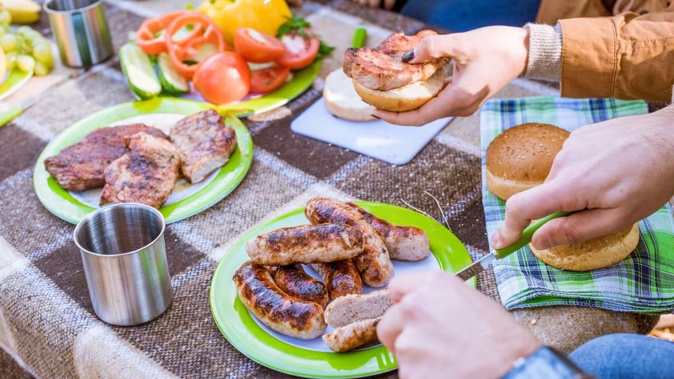
At any Kiwi gathering – from the school fundraiser to the Saturday night potluck – there’s one phrase that strikes equal parts relief and low-level panic: “Just bring a plate.”
It sounds easy, friendly, no fuss. But beneath that breezy instruction lies a rich and complicated etiquette: decades of cultural nuance, unspoken expectations and at least one awkwardly cling-wrapped pavlova.
Unlike the American-style potluck, which often implies real effort and possibly a spreadsheet, the New Zealand “bring a plate” is pitched, at least, as casual. Egalitarian. Just chip in, no stress.
But make no mistake – there is a social contract. Whether it’s a barbecue, a grazing table, a picnic or a shared birthday lunch, what you bring (and how you bring it) says something. And New Zealanders, by and large, know the rules. Even if we don’t say them out loud.
Of course, context matters. The vibe of a grazing table is very different from a backyard barbie or a sports club “ladies, a plate please” situation. Sausage rolls might be acceptable at one and an insult at another. And there’s a fine art to interpreting what’s being asked.
Proper etiquette dictates that you always ask, “What can I bring?” But then, you have to do it. If the host says, “Just something sweet,” you do not show up with a tray of devilled eggs or a lukewarm pizza.
On the other hand, if the host says, “Whatever you like,” the stakes become higher. That’s not an invitation to show up thoughtless – it’s an invitation to read the social temperature and choose well.
“I’m pretty easy-going, but when someone brings a packet of Griffin’s Chockie Chippies as their dessert option, my eyes will roll,” says Janice*. “It’s not even a full-effort supermarket dessert. It’s kids’ bad lunchbox food.”
There’s also the “just bring what you want to eat” loophole – which is not a licence to bring only what you like, and then sulk if others get to it first. If you rock up to a sausage sizzle with one gourmet sausage and one piece of eye fillet and expect them to be cooked with reverence, you’re in the wrong country. They’re going on the grill with the Sizzlers and the chewy rump, and your wagyu cube will be indistinguishable within minutes.

If you're going to bring a fancy cut of meat to a barbecue, be prepared to fight for it come serving time. Photo / 123rf
Some of the most sacred rules are not about what you bring, but how. Plastic wrap over a hot dish that’s now gone cold? Risky. A container that requires oven reheating but has no instruction or warning? Social sabotage. There is no greater potluck tension than discovering the only protein on offer is buried in a lasagne that needs 45 minutes at 180C and there’s already a tray of sausage rolls hogging the oven.
And yet: overthink it and you’re that person who turns up with handmade lamb koftas and labneh swirls, making the neighbour’s corn chips feel like a personal affront. But from the other side, it’s gotta be hard to have forked out for heritage tomatoes and fresh burrata, only to watch everyone tuck into your week’s salary while you nibble on Tip Top bread and a burnt snag.

Not everyone is working to the same budget so don't overstretch and then pout when others can't or don't make the same effort. Photo / Babiche Martens
“There’s always one show-off,” says one seasoned barbecue-goer. “But I don’t mind that. My rule is: don’t skimp on meat. Bad sausages are a no-go. Just … always.”
Food hierarchy exists. Savoury wins over sweet. Hot trumps cold. Homemade always beats store-bought – unless store-bought is fancy (cheesemonger’s brie, artisan crackers etc).
Some swear by bringing nothing that needs refrigeration or heating. Others take pride in turning up with an insulated bag, tongs, backup serviettes and a cake dome. One former flatmate of mine arrived at a “do” with a perfectly layered trifle once – only to find that two others had had the same idea. Nobody brought anything savoury except chippies. “We ate dessert for dinner and no one complained, but we all knew we’d failed,” she says.
“You know it’s a bad spread when there are six bags of chips and no forks,” says Dylan*. “That’s when you realise we probably should have planned. Or at least messaged the group chat first.”
Of course, it’s not just the food that’s policed. There’s a silent but iron-clad rule that if it’s BYO, you’d better bring enough. Turning up with two cans of beer and spending the night working your way through someone else’s pinot gris is a social crime from which reputations may never recover. And expect raised eyebrows if you try to leave with the half-dozen beers you didn’t offer round.
Despite the pitfalls, “bring a plate” works – and that’s the real magic. It’s the kind of communal catering that reflects something deeply Kiwi: a light mistrust of hierarchy, a preference for group effort over grand hosting, and a comfort with the perfectly imperfect.
And yes, it’s always best to leave your leftovers behind – unless they’re actively returned to you. Taking home your own uneaten pasta salad, especially in your own container with the lid at the ready, is a move that says, “I never truly let it go.”
So next time you see “just bring a plate”, take a breath. You don’t have to overthink it – but you do have to think about it. Show some balance, contribute with care and, whatever you do, avoid the grab-and-go bag of cheap bikkies. Some of us are still recovering.
*Names changed to protect the bring-a-plate overthinkers.
Herald contributor Nikki Birrell has worked in food and travel publishing for nearly 20 years. From managing your kitchen to cutting costs, she’s shared some helpful advice recently, including how to prep your barbecue for summer grilling, gourmet hacks for elevating budget ingredients and what toppings to choose for different crackers.
Take your Radio, Podcasts and Music with you









